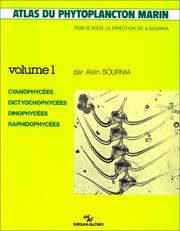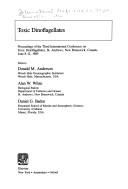| Listing 1 - 10 of 10 |
Sort by
|
Book
ISBN: 3036561978 3036561986 Year: 2023 Publisher: [Place of publication not identified] : MDPI - Multidisciplinary Digital Publishing Institute,
Abstract | Keywords | Export | Availability | Bookmark
 Loading...
Loading...Choose an application
- Reference Manager
- EndNote
- RefWorks (Direct export to RefWorks)
Dinoflagellates are an important group of aquatic microbial eukaryotes, showing great diversity in life histories, ecological niches, morphology, and pigment composition. They include species with photosynthetic, heterotrophic, symbiotic, mixotrophic, and parasitic lifestyles, and encompass coral symbionts, harmful algal bloom forming species, and important fish parasites. They are present in fossil records that date back several hundred million years. Dinoflagellates include the majority of species that produce marine biotoxins, impacting aquaculture. In recent years, molecular approaches have been applied to understand dinoflagellate biology, including techniques for studying dinoflagellate ecology, physiology, basic genetics, and evolution. This Special Issue, edited by Professor Shauna Murray, is dedicated to the application and development of molecular approaches for enhancing our understanding of dinoflagellate biology.
Dinoflagellates. --- Dinoflagellata --- Dinoflagellida --- Dinophyceae --- Dinophyta --- Pyrrophycophyta --- Pyrrophyta --- Phytoflagellates
Book
ISBN: 0801470374 9780801470370 9780801451768 0801451760 Year: 2014 Publisher: Ithaca, NY
Abstract | Keywords | Export | Availability | Bookmark
 Loading...
Loading...Choose an application
- Reference Manager
- EndNote
- RefWorks (Direct export to RefWorks)
Dinoflagellates are common unicellular organisms found in all types of aquatic ecosystems and are important contributors to freshwater ecosystems as significant primary producers of biomass. Despite increasing interest in the biology of living and fossil dinoflagellates, there has been no compilation of dinoflagellate species found in North America since 1934, and no keys to species.In Freshwater Dinoflagellates of North America, Susan Carty provides a much-needed taxonomic guide covering Canada, the United States, Mexico, all of Central America, the Caribbean, and Greenland. Features of the book include:• identification of dinoflagellate species,• distribution maps of species,• ecological and morphological keys to genera,• key to species within genus,• lists of references by location,• glossary, and• an extensive illustration program.Following an introductory section on the biology, morphology, and ecology of freshwater dinoflagellates, the species are presented in a field guide format with distribution maps, written descriptions emphasizing notable features, line drawings, and black-and-white and color micrographs.
Freshwater algae --- Dinoflagellates --- Algae --- Freshwater phytoplankton --- Dinoflagellata --- Dinoflagellida --- Dinophyceae --- Dinophyta --- Pyrrophycophyta --- Pyrrophyta --- Phytoflagellates

ISBN: 2222038235 Year: 1986 Publisher: Paris : Editions du CNRS,
Abstract | Keywords | Export | Availability | Bookmark
 Loading...
Loading...Choose an application
- Reference Manager
- EndNote
- RefWorks (Direct export to RefWorks)
SEA WATER --- PHYTOPLANKTON --- ATLASES --- MARINE AREAS --- CYANOBACTERIA --- DICTYOPHYTA --- DINOPHYTA --- RAPHIDOPHYTA --- MARINE PHYTOPLANKTON --- PHYTOPLANKTON --- TAXONOMY --- PHYTOPLANKTON --- ATLASES --- SEA WATER --- PHYTOPLANKTON --- ATLASES --- MARINE AREAS --- CYANOBACTERIA --- DICTYOPHYTA --- DINOPHYTA --- RAPHIDOPHYTA --- MARINE PHYTOPLANKTON --- PHYTOPLANKTON --- TAXONOMY --- PHYTOPLANKTON --- GUIDE BOOKS --- ATLASES
Book
ISBN: 0632009152 9780632009152 Year: 1987 Volume: 21 Publisher: Oxford Blackwell
Abstract | Keywords | Export | Availability | Bookmark
 Loading...
Loading...Choose an application
- Reference Manager
- EndNote
- RefWorks (Direct export to RefWorks)
Dinoflagellata --- Dinoflagellés --- Dinoflagellates --- 582.251 --- Dinoflagellida --- Dinophyceae --- Dinophyta --- Pyrrophycophyta --- Pyrrophyta --- Phytoflagellates --- Flagellatae --- 582.251 Flagellatae --- Dinoflagellates. --- Dinoflagellés
Book
ISBN: 0126191506 1322255482 148327232X Publisher: London ; New York, NY : Academic Press.
Abstract | Keywords | Export | Availability | Bookmark
 Loading...
Loading...Choose an application
- Reference Manager
- EndNote
- RefWorks (Direct export to RefWorks)
Myxomycetes. Myxothallophytes. Mycetozoans --- Palaeobotany --- Dinoflagellates, Fossil. --- Dinoflagellates. --- Dinoflagellates --- Dinoflagellates, Fossil --- Dinoflagellata, Fossil --- Algae, Fossil --- Dinoflagellata --- Dinoflagellida --- Dinophyceae --- Dinophyta --- Pyrrophycophyta --- Pyrrophyta --- Phytoflagellates
Book
Year: 1995 Publisher: Bristol ; Philadelphia, PA ; New York, NY : Biopress limited,
Abstract | Keywords | Export | Availability | Bookmark
 Loading...
Loading...Choose an application
- Reference Manager
- EndNote
- RefWorks (Direct export to RefWorks)
FRESH WATER --- INLAND WATEWAYS --- ALGAE --- CHLOROPHYTA --- EUGLENOPHYTA --- XANTHOPHYTA --- BACILLARIOPHYTA --- CHRYSOPHYTA --- RHAPHIDOPHYTA --- DINOPHYTA --- RHODOPHYTA --- CYANOBACTERIA --- SYMBIOSIS --- ALGAE --- ALGAE --- ALGAE --- ALGAE --- LIGHT MICROSCOPY --- EATING --- FUNGAL DISEASES --- FRESH WATER --- INLAND WATEWAYS --- ALGAE --- CHLOROPHYTA --- EUGLENOPHYTA --- XANTHOPHYTA --- BACILLARIOPHYTA --- CHRYSOPHYTA --- RHAPHIDOPHYTA --- DINOPHYTA --- RHODOPHYTA --- CYANOBACTERIA --- SYMBIOSIS --- ALGAE --- ALGAE --- ALGAE --- ALGAE --- LIGHT MICROSCOPY --- EATING --- FUNGAL DISEASES
Book
ISBN: 9783443010614 9783443010607 9783443010898 9783443010836 9783443010638 9783443010874 3443010601 3443010636 9783443010942 Year: 2009 Publisher: Berlin : Borntraeger,
Abstract | Keywords | Export | Availability | Bookmark
 Loading...
Loading...Choose an application
- Reference Manager
- EndNote
- RefWorks (Direct export to RefWorks)
SUR Systematic Surveys --- systematic surveys --- Algae --- Myxomycetes --- Protista --- Fungi --- Bryophyta = Musci = mosses --- Marchantiophyta = Hepaticae = liverworts --- Anthocerophyta = Anthocerotae = hornworts --- Tracheophyta --- Glaucocystophyta --- Cryptophyta --- Dinophyta --- Haptophyta --- Heterokontophyta --- Ochrophyta --- Chlorarachiophyta --- Euglenophyta --- Plants --- Bryophyta --- Classification
Book
ISBN: 1281033731 9786611033736 0080534414 9780080534411 9780126930153 0126930155 9781281033734 Year: 1996 Publisher: San Diego : Academic Press,
Abstract | Keywords | Export | Availability | Bookmark
 Loading...
Loading...Choose an application
- Reference Manager
- EndNote
- RefWorks (Direct export to RefWorks)
Identifying Marine Diatoms and Dinoflagellates
Diatoms. --- Diatoms--Identification. Dinoflagellates--Identification. Marine phytoplankton--Identification. --- Dinoflagellates. --- Identification. --- Marine phytoplankton. --- Diatoms --- Dinoflagellates --- Marine phytoplankton --- Fungi & Algae --- Botany --- Earth & Environmental Sciences --- Identification --- Dinoflagellata --- Dinoflagellida --- Dinophyceae --- Dinophyta --- Pyrrophycophyta --- Pyrrophyta --- Bacillariophyceae --- Bacillariophyta --- Diatomales --- Diatomophyceae --- Marine plankton --- Marine plants --- Phytoplankton --- Phytoflagellates --- Algae --- MARINE WATER --- DIATOMS --- DINOFLAGELLIDA --- KEYS --- METHODS --- IDENTIFICATION --- SYSTEMATICS

ISBN: 0444010300 Year: 1985 Publisher: New York Elsevier
Abstract | Keywords | Export | Availability | Bookmark
 Loading...
Loading...Choose an application
- Reference Manager
- EndNote
- RefWorks (Direct export to RefWorks)
Dinoflagellates --- Paralytic shellfish poisoning --- Red tide --- Marine Toxins --- Shellfish --- Congresses --- congresses --- poisoning --- Congrès --- Dinoflagellida. --- Marine Toxins. --- Shellfish. --- 582.252 <063> --- 615.918 <063> --- 639.2.09 <063> --- -Paralytic shellfish poisoning --- -Red tide --- -Crustacea --- Mollusca --- Animal Shells --- Toxins, Marine --- Gambierdiscus toxicus --- Gonyaulax --- Gymnodinium --- Peridinium --- Dinoflagellate --- Dinoflagellidas --- Gonyaulaxs --- Gymnodiniums --- Peridiniums --- toxicus, Gambierdiscus --- Phytoplankton --- Tide, Red --- Dinoflagellate blooms --- Shellfish poisoning, Paralytic --- Paralysis --- Seafood poisoning --- Dinoflagellata --- Dinoflagellida --- Dinophyceae --- Dinophyta --- Pyrrophycophyta --- Pyrrophyta --- Phytoflagellates --- Dinoflagellatae. Peridinales. Peridineae. Cilioflagellatae--Congressen --- Vegetable poisons. Fungal poisons. Mycotoxins. Aflatoxins--Congressen --- Diseases of fish. Pests, enemies of fish--Congressen --- -Dinoflagellatae. Peridinales. Peridineae. Cilioflagellatae--Congressen --- -639.2.09 <063> Diseases of fish. Pests, enemies of fish--Congressen --- 615.918 <063> Vegetable poisons. Fungal poisons. Mycotoxins. Aflatoxins--Congressen --- 582.252 <063> Dinoflagellatae. Peridinales. Peridineae. Cilioflagellatae--Congressen --- Crustacea --- -Toxins, Marine --- 639.2.09 <063> Diseases of fish. Pests, enemies of fish--Congressen --- congresses. --- Congrès --- Congresses. --- Marine Biotoxins --- Biotoxins, Marine
Book
ISBN: 3039213644 3039213636 Year: 2019 Publisher: MDPI - Multidisciplinary Digital Publishing Institute
Abstract | Keywords | Export | Availability | Bookmark
 Loading...
Loading...Choose an application
- Reference Manager
- EndNote
- RefWorks (Direct export to RefWorks)
Several species of Dinophysis produce one or two groups of lipophilic toxins: okadaic acid (OA) and its derivatives; or the dinophysistoxins (DTXs) (also known as diarrhetic shellfish poisons or DSP toxins) and pectenotoxins (PTXs). DSP toxins are potent inhibitors of protein phosphatases, causing gastrointestinal intoxication in consumers of contaminated seafood. Forty years after the identification of Dinophysis as the causative agent of DSP in Japan, contamination of filter feeding shellfish exposed to Dinophysis blooms is recognized as a problem worldwide. DSP events affect public health and cause considerable losses to the shellfish industry. Costly monitoring programs are implemented in regions with relevant shellfish production to prevent these socioeconomic impacts. Harvest closures are enforced whenever toxin levels exceed regulatory limits (RLs). Dinophysis species are kleptoplastidic dinoflagellates; they feed on ciliates (Mesodinium genus) that have previously acquired plastids from cryptophycean (genera Teleaulax, Plagioselmis, and Geminigera) nanoflagellates. The interactions of Dinophysis with different prey regulate their growth and toxin production. When Dinophysis cells are ingested by shellfish, their toxins are partially biotransformed and bioaccumulated, rendering the shellfish unsuitable for human consumption. DSP toxins may also affect shellfish metabolism. This book covers diverse aspects of the abovementioned topics—from the laboratory culture of Dinophysis and the kinetics of uptake, transformation, and depuration of DSP toxins in shellfish to Dinophysis population dynamics, the monitoring and regulation of DSP toxins, and their impact on the shellfish industry in some of the aquaculture regions that are traditionally most affected, namely, northeastern Japan, western Europe, southern Chile, and New Zealand.
WitOMI analysis --- n/a --- DST accumulation --- mussel --- dinophysistoxins --- depuration --- human health --- pectenotoxins (PTXs) --- cryptophytes --- Mesodinium --- dinophysis --- compartmentalization --- resistance --- Japanese scallop --- surf clam --- HAB monitoring --- toxins --- organic matter --- OMI analysis --- PTXs --- time-series --- Diarrhetic shellfish toxins --- predator-prey preferences --- immunity --- okadaic acid --- physical–biological interactions --- defense --- digestion --- Dinophysis --- harmful algal blooms --- pectenotoxin --- El Niño Southern Oscillation --- lysate --- suspended particulate matter (SPM) --- D. caudata --- mixotrophic cultures --- Mytilus galloprovincialis --- bivalves --- diarrhetic shellfish poisoning --- biotransformation --- Mesodinium cf. rubrum --- RNA-Seq --- DST esterification --- Mesodinium rubrum --- statistical analysis --- seasonality --- mass culture conditions --- D. acuminata-complex --- Argopecten purpuratus --- harmful algal bloom --- pipis (Plebidonax deltoides) --- DTX-2 --- Reloncaví Fjord --- pectenotoxins --- deep sequencing --- climatic anomaly --- Brazil --- qPCR --- high throughput sequencing --- DSP --- accumulation --- LC/MS/MS --- Protoceratium reticulatum --- shellfish toxicity --- transcriptomic response --- New Zealand --- blooms --- trophic transfer --- metabolism --- bacterial community --- kinetics --- marine biotoxins --- diarrhetic shellfish toxins --- bivalve shellfish --- Diarrhetic Shellfish Toxins (DST) --- diarrhetic shellfish toxins (DST) --- Scotland --- Dinophysis acuminata --- DSP toxins --- toxin accumulation --- Southern Annual Mode --- Diarrheic Shellfish Poisoning --- Dinophysis toxins --- OA --- marine toxins --- toxin vectors --- wild harvest --- Dinophysis acuta --- Sydney rock oyster (Saccostrea glomerata) --- Argopecten irradians --- dinophysistoxin --- Port Underwood --- aquaculture --- niche partitioning --- Dinoflagellates. --- Dinoflagellata --- Dinoflagellida --- Dinophyceae --- Dinophyta --- Pyrrophycophyta --- Pyrrophyta --- Phytoflagellates --- physical-biological interactions --- El Niño Southern Oscillation --- Reloncaví Fjord
| Listing 1 - 10 of 10 |
Sort by
|

 Search
Search Feedback
Feedback About UniCat
About UniCat  Help
Help News
News